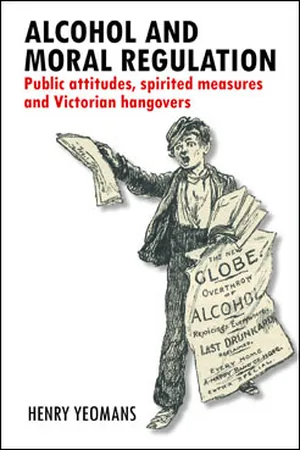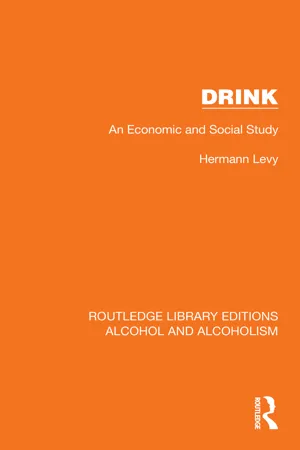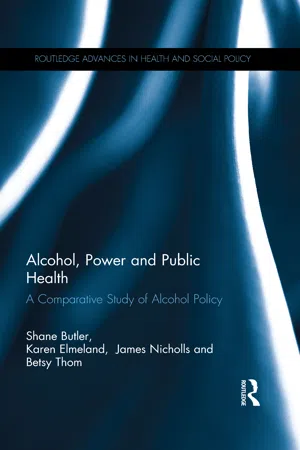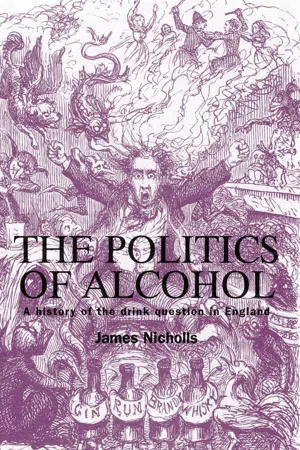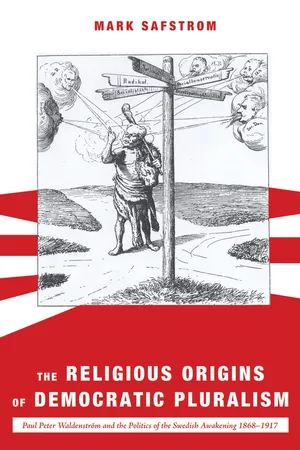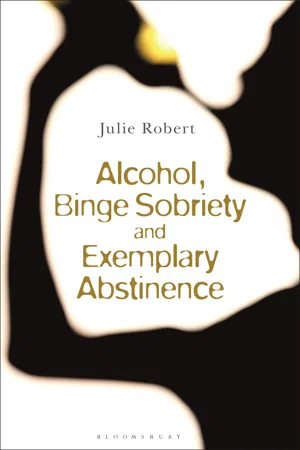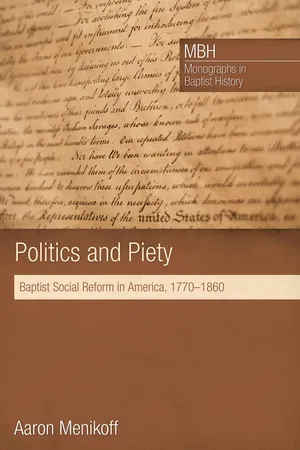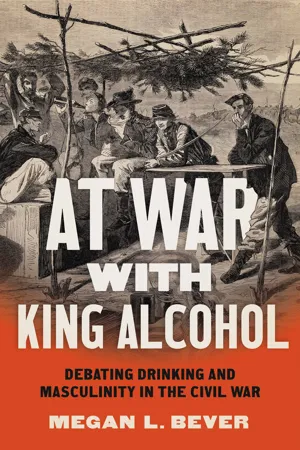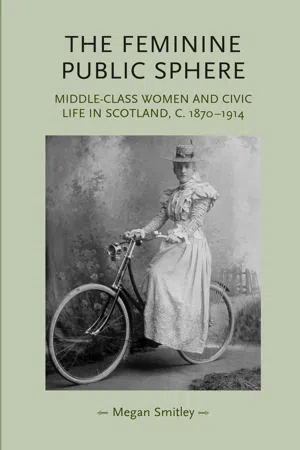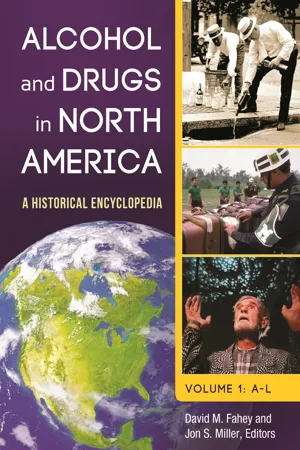History
Temperance Movement
The Temperance Movement was a social and political campaign in the 19th and early 20th centuries that aimed to reduce or prohibit the consumption of alcohol. It was driven by concerns about the negative effects of alcohol on individuals and society, and it led to the establishment of organizations and laws promoting temperance and prohibition.
Written by Perlego with AI-assistance
Related key terms
Related key terms
1 of 4
Related key terms
1 of 3
12 Key excerpts on "Temperance Movement"
- eBook - ePub
Alcohol and Moral Regulation
Public Attitudes, Spirited Measures and Victorian Hangovers
- Yeomans, Henry(Authors)
- 2014(Publication Date)
- Policy Press(Publisher)
TWOTemperance and teetotalism
Introduction
This book concerns the historical development of public attitudes and the regulation of alcohol. Within this broad remit, the last chapter noted the potential salience of the Victorian Temperance Movement to these issues and outlined the book’s specific intentions to explore this further. How did this social movement relate to public attitudes to alcohol and the governance of drinking in England and Wales? This chapter will investigate this question through an examination of public discourse on alcohol and legal sources before and during the period in which the Temperance Movement emerged. Somewhere in the region of 500 newspaper and periodical sources have been considered and, additionally, a number of other sources are used, from David Wilkie’s painting ‘The Village Holiday’ to A History of Teetotalism in Devonshire by the West Country temperance activist W. Hunt. These sources supplied a large quantity of evidence with which certain key issues are explored. What were the views of the first wave of temperance followers? Did these differ from 18th-century concerns about drinking? How did the Temperance Movement relate to the legal and ideological context of its period?The emergence of the British Temperance Movement could feasibly be explained, using either moral panic theory or the rational, objectivist model of alcohol policy, as a straightforward response to a liberal legal stimulus. The first British temperance groups were formed in the late 1820s, before spreading across the country in the 1830s. The advent of temperance societies, therefore, coincided with a period of licensing reform, most notably engendered by the Beer Act 1830. This was a liberalising piece of legislation, which enabled householders to sell beer without the permission of the local licensing justice. This Act, in addition to the gradual replacement of domestic brewing with large-scale commercial brewing,1 coincided with a surge in the numbers of premises nationwide selling beer and an accompanying increase in the number of arrests for drunkenness.2 - eBook - ePub
Drink
An Economic and Social Study
- Hermann Levy(Author)
- 2023(Publication Date)
- Routledge(Publisher)
The Temperance Movement tries to achieve voluntarily, by mere moral suasion, what legislation would attempt by means of prohibition: once a person abstains from the consumption of drink of his own will the immediate effect is much the same as if prohibition had rendered alcohol unavailable. The Temperance Movement or any movement which leads to abstention through moral suasion is therefore more comprehensive in its scope and more complete in its effect on the individual than any legislation based on partial restriction only. Legislation restricts the individual’s freedom to drink and affects the whole population in this limited way: the only criterion for success in moral suasion is the abatement of drinking as a step towards the ultimate goal of total and general abstention.The distinction between voluntary abstention and legal restriction has never been very strictly recognised by historians of the Temperance Movements. No doubt the Temperance Movements have always had this double function in mind: to influence the individual by suasion and education on the one hand, and to support legislation restricting the consumption of drink on the other. The latter function became more distinct as the movements grew in numerical strength and public recognition, and began to make sustained attempts to influence international opinion and, through this, react on national legislation. But this connection does not alter the fact that the Temperance Movement is in the first instance based on persuading the individual to keep voluntarily away from drink. One can hardly agree therefore with those who range early anti-drink legislation within the scope of the Temperance Movements. This has been done, for instance, in the otherwise excellent article by D. W. McConnell in the American Encyclopædia of the Social Sciences (see vol. XIV, 1935). Though we will follow him and fellow historians a little in their analysis, we shall try to bear in mind the distinction between the trends towards voluntary abstention and legislative restriction.McConnell points out that ‘Temperance Movements are almost as old in the history of humanity as the use of intoxicating drinks . . . the Chinese assert that as early as the eleventh century B.C ., one of their emperors ordered all the vines in the kingdom to be uprooted’. Earlier, the laws of Hammurabi, whose reign in Babylon is estimated to have been around 2000 B.C ., contain very drastic regulations as to wine drinkers; one of them lays down that ‘if a priestess who has not remained in the sacred building shall open a wine shop, or enter a wine shop for drink, that woman shall be burned’.1 This seems therefore to indicate that legislators considered wine shops as something more or less immoral, or, at any rate, not compatible with the life of the religious orders, merely one indication of the close interrelation early in history of the drink problem with religious and moral ideals which has been described in great detail and with much care by E. C. Urwin.2 - eBook - ePub
Alcohol, Power and Public Health
A Comparative Study of Alcohol Policy
- Shane Butler, Karen Elmeland, Betsy Thom, James Nicholls(Authors)
- 2017(Publication Date)
- Routledge(Publisher)
This differed from the alternative view, that alcohol was essentially a beneficial substance – albeit one which could produce an array of harms if misused. Apart from the more radical voluntary teetotallers, most temperance advocates also agreed that the role of the state was primarily to reduce the overall consumption of alcohol through supply-side interventions. Alcohol consumption had to be tackled at a population level because it presented a risk to all drinkers, even if only a proportion ended up falling down the slippery slope to outright destitution. In this regard, Victorian temperance displayed many of the characteristics of later social movements: a shared core perspective, but a diversity of opinion on the most effective policy approaches. As with many social movements the differences could be significant, indeed rancorous; however, the shared enemy of temperance – the drinks industry, or simply ‘The Trade’ as it was known – provided a unified figure against which all sides cohered. While temperance discourse was grounded in moral arguments over rights, responsibilities and social progress, it was also shaped by developments in medical thinking around alcohol use. The work of eighteenth- and early-nineteenth-century medical writers had helped position alcohol as a substance that could create, in some users, a type of habituation that was both distinctive and amenable to quasi-medical interventions. In 1814, a Scottish naval surgeon called Thomas Trotter produced a book entitled An Essay Respecting the Effects Medical, Philosophical and Chemical on Drunkenness and its Effects on the Human Body (Trotter, 1988) - eBook - ePub
The politics of alcohol
A history of the drink question in England
- James Nicholls(Author)
- 2013(Publication Date)
- Manchester University Press(Publisher)
The early temperance societies were born out of an evangelical spirit of social reform which had already produced numerous associations for moral improvement such as the Proclamation Society and the Society for the Suppression of Vice. The American Temperance Society presented a model of how the specific practice of spirit-drinking, which had been the source of widespread social anxiety for most of the preceding century, could provide a coherent focus for evangelical reform. Finally, the reorganisation of spirits duties in 1825, and the ensuing increase in consumption, sparked off a wave of social anxiety which provided fertile ground for cultivation of organised temperance. However, had the Temperance Movement remained the marginal activity of a few relatively affluent evangelicals it is unlikely it would have had much of a social impact; it certainly would not have led to the long-running and politically charged disputes over temperance that will be discussed in the following chapters. In order for that to happen the conservative notion of partial abstinence and moderate drinking which underpinned the first temperance societies had to be supplanted by the radical idea of total abstinence which drove the second wave of the temperance campaign.The teetotal revolution
As we have seen, the idea of total abstinence was not new in 1830; and while it was extremely unusual to abstain from all alcohol, it was not something limited solely to a handful of cranks and eccentrics. Indeed, a debate had already been taking place as to the relative merits of abstention as against moderation. In 1794, the author of a Treatise on the True Effects of Drinking Spirituous Liquors, Wine and Beer argued against moderate drinking on the grounds that ‘the words moderately taken express nothing at all, for a certain quantity may not affect a strong man and another may be very much hurt by it’.10 Basil Montagu, writing twenty years later, set out a detailed refutation of the Quaker doctrine of moderation and listed a series of arguments for total abstinence, including the claim that ‘abstinence is easier than temperance’.11 - eBook - ePub
Music and Performance Culture in Nineteenth-Century Britain
Essays in Honour of Nicholas Temperley
- Bennett Zon, Bennett Zon(Authors)
- 2016(Publication Date)
- Routledge(Publisher)
Initially, like many Victorian moral reform movements, members of the middle and upper classes led temperance as paternalistic reform (starting from 1815). This early temperance focused on moderation, recommending that the working classes drink beer rather than stronger spirits, such as gin. By mid-century, however, temperance was linked explicitly with religion. Temperance workers used many of the same strategies as Evangelical religionists, such as home visits, praise services, etc. to promote temperance throughout England. At the same time, the tactics of the Temperance Movement switched from condoning moderation to agitating for complete and total abstinence. This can be seen throughout the century via the increasing use of the word ‘teetotaler’ to describe individuals who abstained from alcohol over the word ‘temperate’. 6 The political conversation around temperance also shifted from reforming the individual to saving the entire society, via both moral suasion and, increasingly, regulation banning the sale of alcoholic beverages during certain times or in certain places. 5 The best histories of Victorian English temperance remain Lilian Lewis Shiman’s Crusade against Drink in Victorian England (New York: St. Martin’s Press, 1988) and Brian Harrison’s Drink and the Victorians: The Temperance Question in England, 1815–1872 (London: Faber and Faber; Pittsburgh: University of Pittsburgh Press, 1971). A shorter introduction can be found in Rebecca Smith’s The Temperance Movement and Class Struggle in Victorian England (Chicago: Loyola University, 1993 [ http://www.loyno. edu/~history/journal/1992–3/smith-r.htm, accessed 9 June 2011]. 6 The origins of the word teetotaler – supposedly coined in the 1830s by the Preston Temperance Society – show that even in the early years of the English Temperance Movement, many thought moderation in drink was not enough - eBook - ePub
The Religious Origins of Democratic Pluralism
Paul Peter Waldenström and the Politics of the Swedish Awakening 1868–1917
- Safstrom(Author)
- 2016(Publication Date)
- Pickwick Publications(Publisher)
334 the Swedish Temperance Movement became a practical outlet for a variety of other ideologies that were current. Revival Christianity often called for concrete changes of lifestyle and the application of one’s faith to life and society, and this was certainly also the case among the Swedish Pietists. For different reasons, Socialists also sometimes identified alcohol consumption and alcoholism among the cultural and financial hindrances that prevented the working class from progress. The Temperance Movement offered an outlet for both of these populations to express their critiques of the relationship of the Swedish public to alcohol, and these unlikely allies could find common ground within temperance organizations. Regardless of the ideological origins, what temperance called for was a restriction of behavior, and thus a restriction on individual freedom. Either the individual could learn to restrict his or her own behavior and preferences and choose to do this freely, or society could do it for them through legal restrictions, or a combination of both. Whether alcohol was presented as merely posing a health hazard, an economic drain, or as a morally defined “evil,” opponents who wanted to maintain their recreational pastimes, or who did not want to lose the income they made from alcohol sales, would cast these efforts as moralism and intolerance. The card that these opponents often played in their defense was an appeal to individual liberty as a foundational concept for democracy. Temperance advocates and opponents thus pitted different aspects of democratic theory against one another.One of the classic ways used to discuss the Swedish Temperance Movement is to divide it into two camps, between absolutists and moderates; absolutists being the people who wanted complete prohibition of alcohol, and the moderates being those who simply wanted restrictions.335 This interplay between moderates and absolutists makes for interesting speculation about the overall outcome of the Temperance Movement in Sweden, namely the failure of prohibition proposals in 1922 and the success of the so-called Bratt System of government-run alcohol regulation. Historian Lennart Johansson took up the question of the origins of what he called Systemet lagom , which can be translated as “the moderate system” or the “middle system” (lagom meaning “just right”). Whereas previous scholarship had assumed that absolutism was a foreign, Anglo-American influence, which was outdone by the more indigenous moderate temperance perspective of Per Wieselgren, Johansson demonstrates that absolutism had a much stronger hold in Sweden.336 - eBook - ePub
- Edith S Gomberg(Author)
- 2019(Publication Date)
- Routledge(Publisher)
The New Temperance Movement: Through the Looking-Glass Dwight B. Heath, PhDSUMMARY . A long-term rise in drinking by Americans slowed in the 1970s and then reversed; several interest-groups pressed for higher taxes on alcohol, server-liability, severe penalties for drunk-drivers, a higher purchase-age, and many other legislative and regulatory restrictions. Several similar changes are occurring in other countries. A quasi-scientific rationale for reducing alcohol consumption links quantity directly to a wide range of social and individual problems, although the correlation often varies, both crossculturally and over time in the U.S. The new Temperance Movement holds out the false promise of a quick and easy solution to drinking problems, and provides a socially acceptable outlet that allows people to blame alcohol and wrongdoers in a Neo-Victorian complacency.In any discussion about current controversies in the drug field, one of the most pervasive and visible ones has to do with increasing pressures to reduce the consumption of alcoholic beverages among all populations. Ironically, it is also a controversy that is perceived as such by few other than those who have taken a strong stand on one side or the other. Many of the principal spokespersons are academicians and other scientists whose writings often are scrupulously phrased in order to minimize controversy, and much that is written on the subject is interpreted as scientifically based and, therefore, straightforward and objective. Besides which, who could be so hard-hearted as to take issue with the World Health Organization’s prescriptions for achieving “Health for all in the year 2000”? Unfortunately, much of what is said along these lines constitutes what many refer to as “the new Temperance Movement,” and it has more to do with politics and emotion than it does with science. - eBook - ePub
- Julie Robert(Author)
- 2022(Publication Date)
- Bloomsbury Academic(Publisher)
The apprehension about unflattering associations notwithstanding, TSIs have largely taken these earlier Temperance Movements as normative examples. They have capitalized on many of their legacies, including their international philanthropic networks, their mustering of both medical and economic arguments, the utility of public commitments and even some of their lesser-known forms of involvement (such as time-delimited initial commitments) to create popular campaigns. The origins, rationales, forms, discourses and even exemplifying practices of temperance have nonetheless been reimagined and made palatable to contemporary audiences in a way that ‘temperance’ as popularly understood could not be.Temperate values on display
Temperance, as Gusfield (1986) established, is often framed as a response, admittedly a symbolic one, to a ‘moral panic’ (Cohen 2002) about alcohol consumption. This is to say that temperance was a reaction to the popular perception that alcohol was a problem that was worsening and that would continue to worsen without intervention. Analyses of both temperance and neo-temperance contexts reveal that in objective terms, alcohol consumption prior to the initiation of renewed calls for regulation and prohibition was in decline (Hunt 1999; Reinarman 1988). Images of alcoholic excess and sensationalist headlines – whether the gin drinking of nineteenth-century working-class England or the binge drinking of young women and ‘alcohol-fuelled violence’ that began to claim the attention of modern news outlets in Britain in 2004 (Berridge 2013) and Australia in 2008 (Azar et al. 2013) – nonetheless presented alcohol as an emergent threat to social order rather than as practices whose effects were mostly felt by individuals, most often individuals who were virtually unknown to the advocates of temperance. The order in question, albeit in different ways, relied upon self-governance as a means of distinction and differentiation. Temperance activities (both old and new), as Levine (1978) influentially argued, were accordingly predicated on the overt manifestation of restraint and responsibility as the symbolic solution to the perceived problem of rampant alcohol consumption. - eBook - ePub
Politics and Piety
Baptist Social Reform in America, 1770–1860
- Menikoff(Author)
- 2014(Publication Date)
- Pickwick Publications(Publisher)
Indeed, the movement owed much gratitude to profound economic, commercial, and political changes. As Rumbarger argued, the Temperance Movement rested at the heart of industrialization, as “wealthy capitalists regarded temperance reform as integral and necessary to establishing a capitalist, industrial social order.” John J. Rumbarger, Profits, Power, and Prohibition: Alcohol Reform and the Industrializing of America, 1800 – 1930 (New York: State University of New York Press, 1989) xix. Furthermore, social and economic factors seemed to explain a difference in attitude between northerners and southerners when it came to temperance. Southerners, who came to depend on the revenue from the grain sold to distilleries, had a real incentive to keep away from abstinence pledges. Ian R. Tyrrell, “Drink and Temperance in the Antebellum South: An Overview and Interpretation,” Journal of Southern History 48 (Fall 1982) 485–510. The first comprehensive work on temperance to treat the religious origins of temperance, John Allen Krout, The Origins of Prohibition (New York: Russell & Russell, 1953) is widely dismissed for focusing too much on the religious roots and generally failing to provide an interpretation of temperance reform. It was followed by Joseph Gusfield, Symbolic Crusade: Status Politics and the American Temperance Movement (Urbana: University of Illinois Press 1963) which had a similar emphasis on the religious underpinnings of the movement. However, more recently, temperance historians have moved away from the religious backdrop and emphasized the social origins. See Ian R. Tyrrell, Sobering Up: From Temperance to Prohibition in Antebellum America, 1800 – 1860 (Westport, CT: Greenwood, 1979); Robert L. Hampel, Temperance and Prohibition in Massachusetts, 18 13 – 1852 (Ann Arbor, MI: UMI Research Press, 1982); Jack S. Blocher Jr., American Temperance Movements: Cycles of Reform (Boston: Twayne, 1989); Rumbarger, Profits, Power, and Prohibition ; and Thomas R - eBook - ePub
Civil War America
Debating Drinking and Masculinity in the Civil War
- Megan L. Bever(Author)
- 2022(Publication Date)
- The University of North Carolina Press(Publisher)
By 1836, however, the American Temperance Union had changed its tune and crusaded for total abstinence, hoping to spread its influence by targeting moderate drinkers along with habitual drunks. Reformers relied at first on a strategy of moral suasion: convincing drinkers that it was in their best moral (and financial) interest to sign a pledge of a lifetime of sobriety. Pledge-signing worked to an extent, and the actual influence of the Temperance Movement stretched well beyond the roles of the ATU, Washingtonians, or Sons. By 1850, many Northern communities had passed license laws to regulate alcohol sales, and consumption plummeted. These license laws disappointed reformers. They curbed, rather than eliminated, drinking. Worse, regulatory measures undercut the total abstinence crusade by permitting moderate drinking. In response to license laws and the limited effects of moral suasion, the ATU turned by the 1850s to a new strategy: legal suasion. Temperance reformers in Northern states mounted crusades to convince state legislatures to pass legal prohibition. Maine enacted such a measure in 1851. Other Northern states followed suit, referring to their laws as “Maine Laws.” 11 Southern states hesitated to jump on the prohibition bandwagon in the 1850s, but that does not mean that temperance reform was solely a Northern phenomenon. Some historians have argued that white Southerners felt wary of radical movements that sought to upset the status quo, and they recognized a close relationship between temperance reformers and abolitionists. 12 Other historians disagree, arguing persuasively that the limited support for temperance in the South probably had more to do with the fact that the great majority of white Southerners lived on farms. Distilling, after all, effectively preserved fruits and grains, a necessary part of Southern agricultural life - eBook - ePub
The feminine public sphere
Middle–class women and civic life in Scotland, c. 1870–1914
- Megan Smitley(Author)
- 2013(Publication Date)
- Manchester University Press(Publisher)
5Moral suasion conformed to evangelical notions regarding an individual’s capacity for personal redemption. Moral suasionists viewed the drinker as a morally responsible individual, whose conscious choosing of total abstinence was vital to a sustained rejection of alcohol.6 In the words of John Stuart Mill: ‘People could only progress morally if their freedom of choice remained unfettered, so drunkenness should only be punished when it was contrary to the public interest.’7 For this reason, moral suasion focused on educating individuals with the aim of promoting a teetotal lifestyle.8 Echoes of the evangelical conversion experience reverberate in moral suasion in which the drunkard’s choice of total abstinence mirrored the redemptive path of personal salvation and self-help. Moral suasionists opposed prohibition using two main arguments: firstly, that legislative means of reform interfered with personal liberty; and secondly, that legislation alone was insufficient to end the ‘evil of intemperance’, and a fundamental shift was needed in (especially working-class) attitudes towards drink and drunkenness.Reforming activities guided by moral suasion in the BWTASCU were directed by evangelistic departments. The Scottish-national Evangelistic Department was established in 1895 under the leadership of Mrs McKinnon née Miller, the daughter of a Rothesay harbourmaster and wife of John D. McKinnon, reverend of the Dumfries South Free Church.9 Evangelistic work had two main purposes: firstly, to win souls for temperance by promoting the temperance pledge; and secondly, to counter antagonism to the Temperance Movement within the Christian community. McKinnon’s Evangelistic Department aimed to accomplish these goals by organising Gospel Missions to be taken over by local BWTASCU branches.10 - eBook - ePub
Alcohol and Drugs in North America
A Historical Encyclopedia [2 volumes]
- David M. Fahey, Jon S. Miller, David M. Fahey, Jon S. Miller, David M. Fahey, Jon S. Miller(Authors)
- 2013(Publication Date)
- ABC-CLIO(Publisher)
The mechanization of work and the movement of work from the family setting into organizations driven by time and by written rules made alcohol an enemy of work rather than as an integrated or helpful adjunct. In the United States, the decoupling of work and drinking occurred in a context where new forms of social control emerged in response to major intersecting forces of social change. Industrialization and reorganization of work resulted in new relationships and the creation of the “employee” and the “employer,” paralleling in some ways earlier servant-master relationships. Manpower needed for rapid industrialization growth fueled migration from farm to city and immigration from Europe and Asia, with a resultant need for resocialization and “Americanization” into norms of productivity, saving money, achievement, and the segregation of play from work. New factories and their workforces evolved into new and expanded cities, with crowded living creating a multitude of new demands for human order, within which uninhibited drinking had little place. Drinking rapidly evolved from an integrated part of everyday life into a major social problem. All of these forces combined into fertile ground for the American Temperance Movement.CONTROLS ON EMPLOYEES AND ALCOHOL USEThe scenario that emerged centered on the need for control. As early as the 1820s, an idea that began to gain traction was that there was no place for alcohol in American society. This began with a distinction between “safe” beer and wine and “dangerous” and “evil” distilled spirits, but quite quickly condemnation spread to all alcohol. Gusfield effectively argues that the “old line” Americans whose identities centered on Protestantism and rural agricultural values found themselves threatened by the mass of immigration and urbanization, with alcohol use symbolic of all that was wrong with the upheaval of change in the United States. The Temperance Movement quickly became the abstinence/prohibition movement.The urban immigrant male factory worker with a family to support was the core icon of the movement. While the attraction of the Temperance Movement was far from universal, it definitely touched major chords in those who saw themselves surrounded by chaotic change. As the 19th century progressed, momentum was added with the creation of the Anti-Saloon League. With the icon described above, the workingman drinking to abandon in the saloon and spending the wages essential to support his family completed the picture of the reform that was needed.
Index pages curate the most relevant extracts from our library of academic textbooks. They’ve been created using an in-house natural language model (NLM), each adding context and meaning to key research topics.
Explore more topic indexes
Explore more topic indexes
1 of 6
Explore more topic indexes
1 of 4
